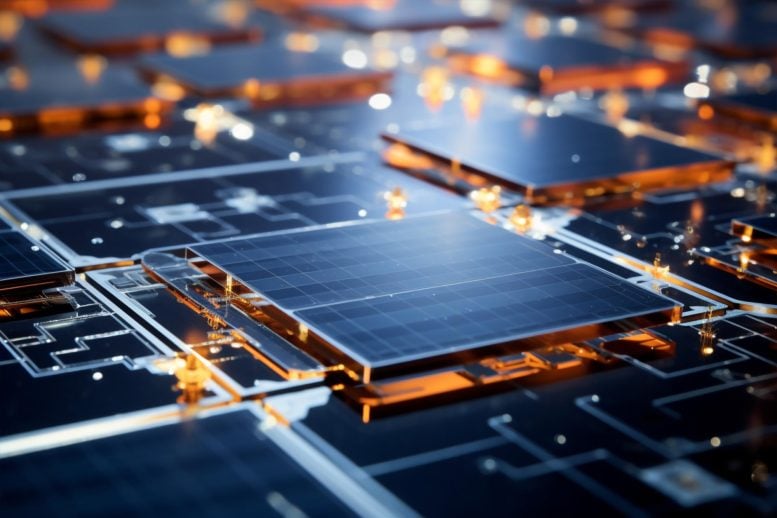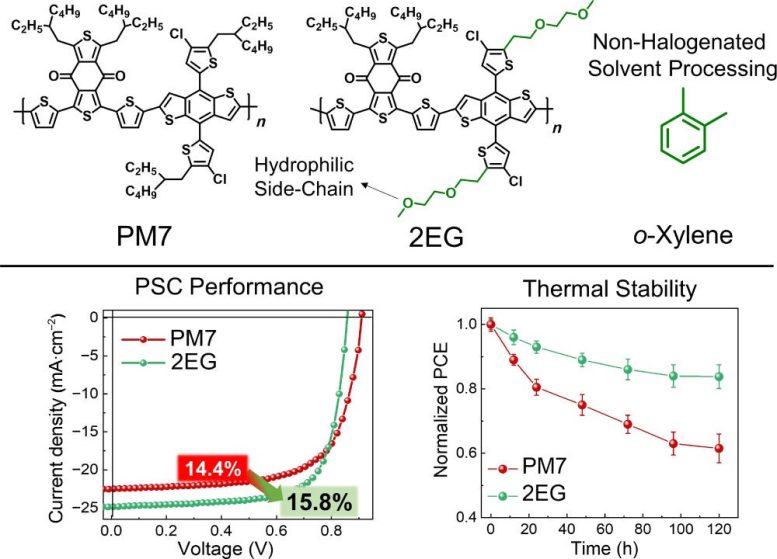
Researchers have made major advances in polymer solar cell technology by developing a method that improves molecular interactions using side chain technology. This method eliminates the toxic halogenated processing solvent, thereby increasing cell viability and stability. Research highlighting the advantages of oligoethylene glycol (OEG) side chains is an important step toward clean, efficient solar cells suitable for portable devices. Photo: SciTechDaily
Known to be lightweight and flexible, polymer solar cells are ideal for portable applications. However, its widespread use has been hampered by the toxic halogenated solvents required for production. These liquids cause environmental and health hazards, limiting the use of these solar cells. Unfortunately, alternative, less toxic liquids do not have the same solubility and require higher temperatures and longer processing times.
This inefficiency makes the adoption of polymer solar cells more difficult. Developing a method to remove halogenated solvents can greatly improve the performance of organic solar cells, making them suitable for portable technologies.
Researchers describe in a recently published paper how improving the molecular interactions between polymer donors and small molecule acceptors can reduce the solubility of halogenated solvents.
The paper was recently published in the journal Nano Research Energy.
"The morphology of donor-acceptor small-molecule polymers depends largely on molecular interactions, and can be determined by the interfacial energy between donor and acceptor materials. Yoon Hye Kim, a professor at Gyeongsang National University in Jinju, Republic of Korea, said that when their interfacial tension values are close, the interfacial energy between donors and acceptors Surface energy and molecular interactions are expected to be more favorable.Hydrophilicity and molecular separation of donor polymers can be reduced, side chain engineering may be a promising approach.
Introduction to side chain development
Side chain engineering occurs when a chemical group, called a side chain, is added to the main chain of a molecule. The chemical groups in the side chain affect the properties of the larger molecule. The researchers hypothesized that the addition of an oligoethylene glycol (OEG) side chain would improve the hydrophilicity of the donor polymer due to the oxygen atoms in the side chain. A hydrophilic molecule is attracted to water.

A mixture of hydrocarbons and hydrophilic oligoethylene glycol (2EG) is used to produce PSCs with better overall performance and thermal stability than standard solvents. Photo: Nano Research Energy, Tsinghua University Press
Differences in hydrophilicity of polymer donors and small acceptor molecules can affect their interactions. Due to the high hydrophilicity of the donor polymers and the better interaction between them and small acceptor molecules, non-halogenated solvents can be used for processing without affecting the performance of solar cells. Indeed, benzodithiophene-based donor polymer solar cells with OEG-based side chains had a higher energy conversion of 17.7% compared to 15.6%.
More efficiency and stability.
To compare the results, the researchers used benzodithiophene-based donor polymers with an OEG side chain, a hydrocarbon side chain, or a side chain composed of 50% hydrocarbon and 50% OEG. "This explains the effect of side chain technology on hybrid morphology and performance of non-polymer solar cells," said Kim. "Our results indicate that polymers with hydrophilic OEG side chains increase their miscibility with small receptor molecules and improve the energy conversion efficiency and device stability of the polymeric solar cells in the non-halogenated process."
In addition to improved power conversion efficiency, polymeric solar cells with OEG-based side chains have improved thermal stability. Thermal stability is important for measuring polymer solar cells, so the researchers heated them to 120 degrees Celsius and then compared their energy conversion efficiency. After 120 hours of heating, the polymers with hydrocarbon side chains had only 60% of the initial conversion efficiency and surface roughness, while the mixture of hydrocarbons and OGs retained 84% of the energy conversion efficiency.
"Our results may provide useful guidance for developing polymer donors that produce stable and efficient polymer cells by treating them with non-halogen solvents," Kim said.
Reference: "Polymer Donors with Hydrophilic Side Chains Enable Efficient and Thermally Stable Polymer Cells by Treating with Non-Halogenated Solvents", Sudok Seo, Joon-Young Park, Jin Soo Park, Sengjin Lee, Do-Young Choi, Yoon-Hye. Kim and Bumjun J. Kim, 24 July 2023, Nano Research Energy .
DOI: 10.26599/NRE.2023.9120088.
Other authors include Sudok Seo, Jin Soo Park and Bumjun Jae Kim from the Korea Advanced Institute of Science and Technology. Joon Young Park and Do Young Choi, Gyeongsang National University; and Sengjin Lee Korea Chemical Technology Research Institute.
The study was funded by the Korea Energy Assessment and Planning Institute and the National Research Foundation of Korea.



